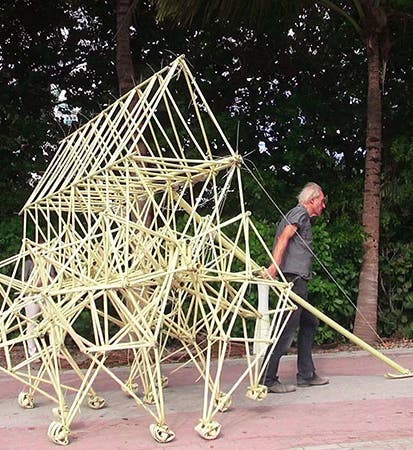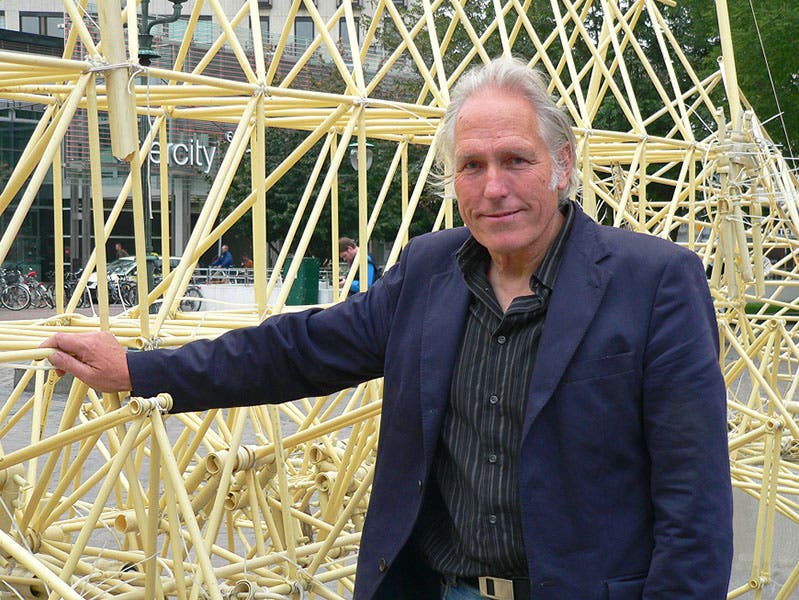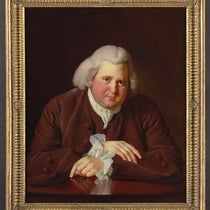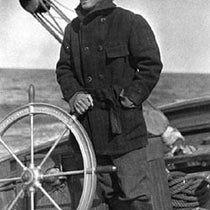Scientist of the Day - Theo Jansen
Theo Jansen, a Dutch artist, sculptor, and engineer, was born Mar. 14, 1948, in Scheveningen, in the Netherlands. Since 1990, Jansen has been fashioning lumbering creatures, made mostly of ordinary PVC pipe, that wander up and down the nearby beaches of the North Sea, driven by the wind. He calls his creations strandbeesten – beach animals. Since sand is not kind to wheeled mechanisms, a strandbeest does not roll along; it rather walks, lifting its many legs like a caterpillar walking sideways. The original strandbeesten were large to start with, the size of small cars, and have grown to the size of dinosaurs over the past 34 years.
One might call Jansen a kinetic artist, or kinetic sculptor, since his creations move, and he is also an engineer of considerable talent, since it is not easy to get a PVC walker to stay level while its legs churn up and down. They harness the wind with windmill-like vanes, or sails, or flapping wings. The early strandbeesten simply moved where the wind pushed them, but more recent offspring (all of which bear Latin names, such as Animaris adulari) have sophisticated mechanical mechanisms that will turn them away from the water, should they wander that way, or even reverse their motion should they run into something. Jansen likes to call this "evolution," but all of the evolving really takes place in Jansen's creative mind. He is the Intelligent Designer who learns from his mistakes, which is what a really Intelligent Designer ought to do.
There is not much point in talking about Jansen's strandbeesten, or looking at still photographs, since 90% of their appeal lies in their movement. If you have never seen a film of one, the first viewing will take your breath away. It certainly did mine, when I first encountered Jansen many years ago, in a BMW commercial. The beesten must be seen on a Dutch beach, with the stormy gray of the North Sea skies in the background and the wind howling. Strandbeesten have travelled to Miami, and California, and wowed people there, but they are seriously out of their element at an art show, even a kinetic art show. They were made to walk in rippled sand with the waves crashing beside them and the wind rattling everything, so the PVD joints click and clack loudly as the beast churns its way through and over the sand.
We will start you off with a video produced by the New Yorker in 2011, when they did a piece of Jansen. It is two minutes long. I would link to the article, which is excellent, but you wouldn’t be able to read it, unless you have a subscription.
This next video can be found on the strandbeest.com website. It is mostly just beasts in action, with a suite by Khachaturian as accompaniment. It was released in 2017, and is just over 4 minutes long
Finally, from the same site, comes a video released in 2021. Some of the shots from 2017 are repeated, but most are new. We get a look at strandbeesten travelling in herds, and also an introduction to a new flying strandbeest. The glorious Khachaturian music is back. This video is also just over 4 minutes long.
If you want more, there are many other videos to be found on YouTube. Jansen also gave a TED Talk in 2007, where he had a strandbeest on the stage with him, and during which he showed some film of beesten on the strand. But if you want music, you will have to hum along.
Jansen’s website offers a model kit of a strandbeest, a simple one, Animarus ordis parvus. I bought one, naturally, when I first encountered Jansen, and put it together, and it sits on my desk at the moment, ready to be put into motion by a battery-powered fan. I thought of making a video of parvus in action, but it would have no business being in the same post as the professional videos above, so I did not. You may view the model, and consider purchasing your own, on the strandbeest website.
I hope Theo Jansen just keeps going and going, like his PVC lifeforms. I just wish I lived in Holland along the North Sea, so I would have a chance of seeing a strandbeest clacketing my way, with Mr. Jansen following behind, like the proud father he surely is.
William B. Ashworth, Jr., Consultant for the History of Science, Linda Hall Library and Associate Professor emeritus, Department of History, University of Missouri-Kansas City. Comments or corrections are welcome; please direct to ashworthw@umkc.edu.








![Using an astrolabe to measure the depth of a well, woodcut in Elucidatio fabricae vsusq[ue] astrolabii, by Johannes Stöffler, 1513 (Linda Hall Library)](https://assets-us-01.kc-usercontent.com:443/9dd25524-761a-000d-d79f-86a5086d4774/a998eb50-55d2-4a88-ace2-a50aa5fa86e7/Stoffler%201.jpg?w=210&h=210&auto=format&fit=crop)

